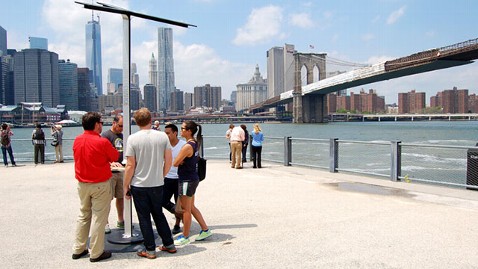After Sandy, AT&T Builds Solar Phone Charging Stations Across NYC

Credit: AT&T
In the days following Superstorm Sandy, Starbucks and other restaurants in the New York City region had lines out the door. The customers were not in line to get coffee or food, but instead to use the electric outlets to charge their dead cell phones.
The administration of New York City Mayor Michael Bloomberg, AT&T and other organizations are now looking to cut down on those lines by erecting solar charging stations across New York City's five boroughs.
"After Hurricane Sandy, I asked our private sector partners to step up and help improve the resiliency of New York City. AT&T is doing just that, and we're grateful for their efforts," Bloomberg said in a statement.
Called the AT&T Street Charge project, the 25 charging stations will be spread out across the city. Many of the first stations, including ones in Riverside Park and Fort Greene Park, began to provide power to low-on-juice phone owners on Tuesday.
In the days after the devastating storm, Verizon and AT&T deployed trucks to provide connectivity and power to Sandy victims.
Designed by Brooklyn design agency Pensa, the charging stations look a lot like the Samsung-sponsored stations you might see in airports, except these have a more natural look to them, are sponsored by AT&T and along the top of the tall structure is a solar panel provided by Goal Zero. Each structure has six USB ports, including three built-in tips - one for an iPhone 5, one for an iPhone 4, and a MicroUSB for an Android or BlackBerry phone - and three female USB ports for people who have their own cords.
According to AT&T, it will take two hours to fully charge a phone with the solar power, but it expects most people just to plug in to get enough juice to get to the next location.
Those wondering if the towers would provide juice after a storm will be happy to know that the solar chargers sip up the sun's energy and UV rays even in cloudy conditions and then store it in the lithium batteries to allow for charging day and night. Each of the Street Charges are positioned, however, to collect the most amount of sunshine.
AT&T added that the units are sturdy, but can be moved in case of a significant weather event and relocated with 24 hours notice.
The Street Charge program is just one of many steps the Bloomberg administration has taken in the wake of the large storm to improve digital tools and communications across the city.
Last week, the city announced a partnership with the neighborhood social network Nextdoor. The network allows people in different neighborhoods to communicate with one another and receive updates about breaking news from the city.
The 25 charging stations will be rolled out over the summer.